Microsoft Surface Pro 3 Review
by Anand Lal Shimpi on June 23, 2014 3:55 AM ESTThickness, Thermals and Core: Understanding how Surface Pro 3 Got so Thin
Ever since Surface RT showed up I've wanted Surface Pro but in the RT chassis. Microsoft seemed to consciously avoid any lower TDP Core processors in favor of Ultrabook SKUs, which pretty much kept Surface Pro thicker than its ARM-based counterpart. Surface Pro 3 changes everything with a rethinking of how Microsoft embraced the thermal constraints of a tablet.
Surface Pro 3 is available with one of three CPU options: a Core i3, Core i5 or Core i7. The latter two are 15W TDP parts, while the former is a 11.5W TDP/6W SDP Haswell Y SKU. Haswell Y is really designed for passively cooled form factors, but all three CPU options receive the same heatpipe and fan cooling system offered by the Surface Pro 3. In short, the Core i3 model should behave a lot more like a standard Ultrabook part (sans Turbo).

Surface Pro 2 (left) vs. Surface Pro 3 (right)

Apple iPad Air (left) vs. Surface Pro 3 (right)
Microsoft's claim to fame is the ability to build the world's thinnest device with a Core series CPU inside. At 9.1mm thick, the Surface Pro 3 is just barely thicker than last year's Surface 2 but with a full blown dual-core Haswell instead instead of a high-end phone/tablet ARM SoC. As both the Surface Pro 2 and Surface Pro 3 used 15W Haswell Ultrabook parts and Microsoft claims a performance increase over last year's model, the question is how Microsoft can reduce thickness, keep TDP the same and increase performance. The answer is simply a difference in what's acceptable from a thermal standpoint.
Here's a look at the original Surface Pro while running an hour long loop of 3DMark Ice Storm Unlimited. I chose this test in particular as it behaves as a nice balance between CPU and GPU workloads on the device:
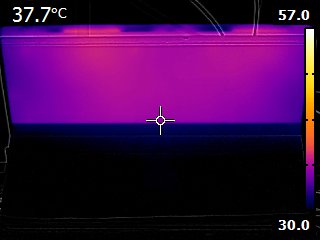
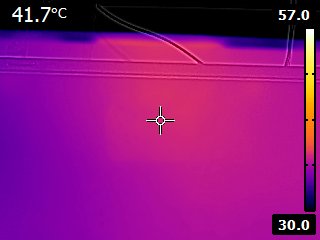
You can almost trace out the path of the heat pipe carrying the thermal load away from the CPU and to the two fans in the system. I measured peak temperature here at 41.7C.
Now let's look at Surface Pro 2:
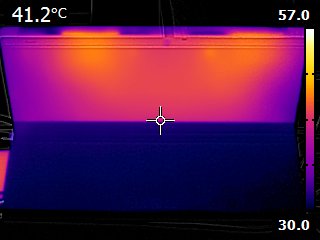
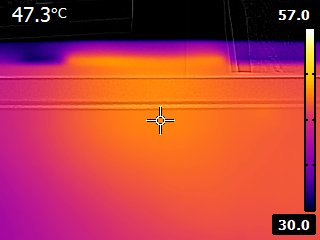
Despite a move to Haswell, Microsoft lets the device get much warmer. You can make out the same U-shape thermal distribution as heat is carried away using the two fans, but the temperatures are much higher. I measured a maximum temperature running the same workload of 47.3C.
Here we have Surface Pro 3:
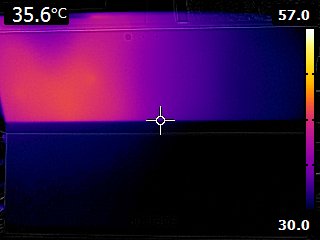
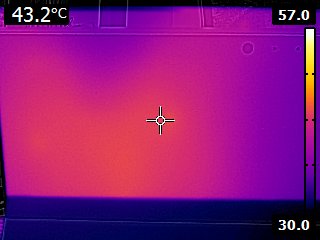
Right away you can see the new cooling system at work. The thermal load is mostly confined to the left side of the image (we are looking at the back with the kickstand unfolded towards the camera, so if you were looking at the display we're talking about the upper right side of the machine). The cooling solution is far more compact and I suspect ready for a move to Core M (Broadwell). Peak temps however are much closer to Surface Pro 1 at 43.2C.
The thermal story points us in the right direction. Either Surface Pro 3's fan and heatpipe configuration is able to remove heat far better than Surface Pro 2's design could, or the CPU in SP2 doesn't get as warm. I suspect it's the latter.
For starters, I'm guessing that Intel is helping Microsoft with delivering better binned Haswell ULT and Y series SKUs. But the big change is I believe Microsoft is more aggressive about reducing CPU and GPU frequencies in Surface Pro 3 compared to Surface Pro 2. Benchmarks will show an increase in performance due to more aggressive ramping up/down of clock speeds vs. Surface Pro 2, but prolonged load cases will likely show a decrease in performance vs. last year's model.
I first stumbled upon this behavior while trying to gather thermal data for Surface Pro 3. I noticed large run to run variance if I repeatedly ran 3DMark 11. I'm used to seeing this sort of behavior on smartphones that throttle quickly, but it was unique for a Surface Pro device.
3DMark is a synthetic test so the real question was how would Surface Pro 3 perform in a real world scenario where sustained CPU/GPU load was guaranteed for a long period of time. I figured a game playable on the machine like Dota 2 would be a great example. I asked our own Ryan Smith to whip up a custom benchmark using the game and I ran it on Surface Pro 1, 2, 3 as well as a 13-inch MacBook Air (Early 2014). The graph below illustrates average frame rate during our Dota 2 benchmark for all of the systems:
As you can see, even with Surface Pro 3's fan running the platform doesn't deliver sustained performance equal to last year's model. It's an understandable tradeoff given the substantial reduction in device thickness (and thus improvement in usability), but it's important to note nonetheless.
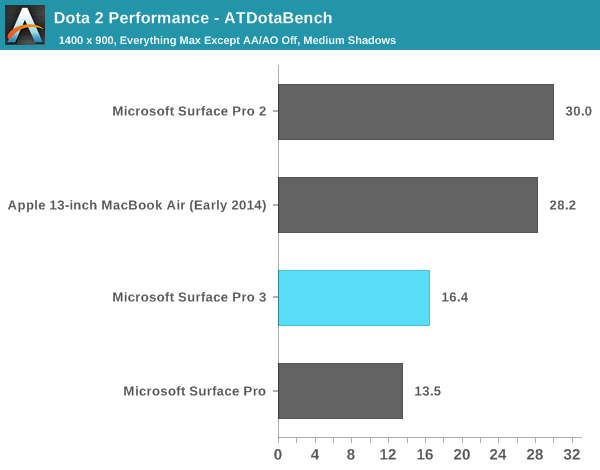
Workloads that are CPU and GPU heavy are one thing, but what about sustained productivity workloads? Penny Arcade's insanely talented artist Gabe mentioned that he noticed substantial lag when drawing on his Surface Pro 3. As Surface Pro 3's NTrig pen is actually lower latency than Surface Pro 2's, I wonder if what Gabe ran into might be thermal related rather than pen related (alternatively it could have to do with the much higher display resolution that Surface Pro 3 runs at). I needed a repeatable workload to see if non-gaming use cases also showed a regression. Thankfully PCMark 8 v2 provides a number of relatively long, repeatable workloads that are great for testing just this.
I decided to use the PCMark 8 v2 Work suite which includes web browsing, office producitivity (word processing and spreadsheet work) and video chat. It's a far cry from a Cinebench loop but I figured if I saw throttling here it would easily be present in heavier workloads. Each run of the suite actually repeats the tests three times and takes around 20 minutes to complete on the Surface devices. I measured performance for three suite runs (9 total runs of the Work loop) on both Surface Pro 2 and 3:
| PCMark 8 v2 Work Performance Over Time | |||||||
| Work Suite Run #1 | Work Suite Run #2 | Work Suite Run #3 | |||||
| Microsoft Surface Pro 3 (Core i5) | 3273 | 3031 (92% of peak) | 3129 (95% of peak) | ||||
| Microsoft Surface Pro 2 (Core i5) | 3222 | 3223 | 3218 | ||||
As you can see, there's a 9% drop in performance on Surface Pro 3 from the first suite run to the next while Surface Pro 2 delivers consistent performance between runs. By the third run Surface Pro 3's performance recovers a bit, although it's still a few percent below the initial, cool run.
PCMark 8 v2 also plots CPU temperature and frequency throughout the course of the benchmark. Unfortunately I don't think I can export the data so I'm forced to present screenshots from the benchmark harness itself. Thankfully even looking at these screenshots is enough to tell us what's going on between the two Surface Pro devices:
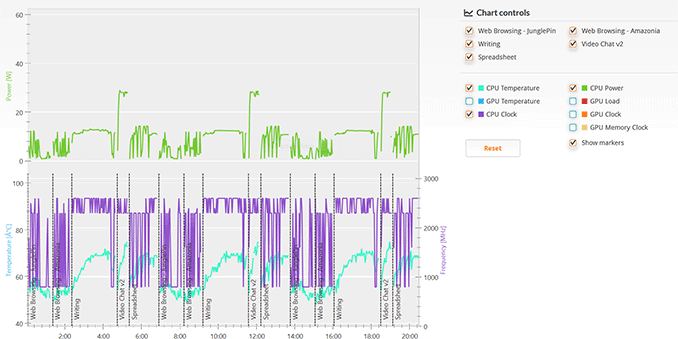
Surface Pro 2 PCMark 8 v2 Work Suite
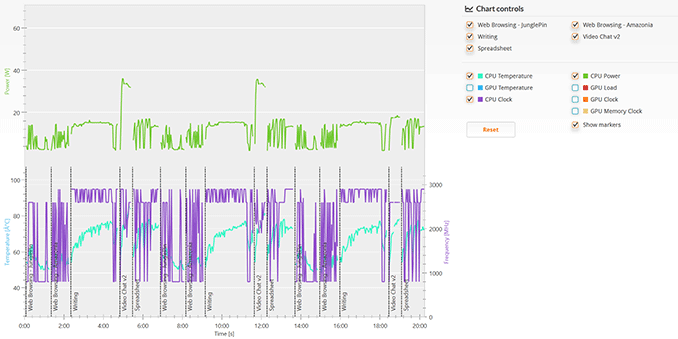
Surface Pro 3 PCMark 8 v2 Work Suite
Both devices do a good job of reaching max turbo fairly regularly, but Surface Pro 2 appears to spend more time at its max turbo state. By the last loop of the benchmark Surface Pro 3's max power is limited (green line) by the time we get to the video chat workload, I suspect that is where we lose a bit of performance. I'm only looking at the last of three suite runs here, if we looked at the second one the results would be even worse.
I haven't tested Surface Pro 3 in Microsoft's new docking station so I don't know if the device changes its thermal profile at all when docked, but in tablet or laptop mode it's definitely going to throttle quicker than Surface Pro 2 did. I must stress that I don't think this is necessarily a bad idea. Surface Pro 3 improves usability over Surface Pro 2 by leaps and bounds, and it's still faster under load than the original Surface Pro. All of this comes at the expense of reduced sustained performance. As you'll see from the rest of our tests, peak performance did get better over last year's model.
Fan Noise
Surface Pro 3's single fan is more noticeable than in Surface Pro 2. The sound it produces isn't necessarily louder, and when spinning it sounds a lot like any other Ultrabook with a fan in it. Compared to Surface Pro 2, the fan does kick in more frequently. For light tablet workloads or even light office work on Surface Pro 3, the fan remains silent. It's only when you're doing anything CPU or GPU intensive that you'll hear it spin up. The big difference is that in situations where you wouldn't hear fans spinning on Surface Pro 2, you'll sometimes hear it on SP3. This is the tradeoff that comes with the thinner chassis.










274 Comments
View All Comments
nerd1 - Monday, June 23, 2014 - link
I won't touch anything with that terrible resolution TN screen, even with a stick.TEAMSWITCHER - Monday, June 23, 2014 - link
I have one...and I love it!!I use a desktop as my daily workhorse (OS X and Windows) but always need a laptop for traveling or when I want to get out of the office for a while. I don't need much power to edit source code so I went for extreme portability: I surprise people when I pull it out of the case I'm holding - they mistake it for an iPad.
Yes, the screen is small but workable with full screen apps. The color is good - I never even realized it was a TN screen. The 16 x 9 aspect ratio is nice for Air Playing content to my Apple TV. When not traveling it doubles as my living room computer.
I'm really looking forward to the next iteration of the MacBook Air. A 12" retina screen in the same 2+ lb portable clamshell design with better battery life would be a nice upgrade.
GC2:CS - Monday, June 23, 2014 - link
Nice comparison but well the MacBook Air still stacks up incredibly well in first three categories if we asume that it's the design from late 2010... That's like ancient history ! And still a tablet PC has problems in leapfrogging that in "Weight" and "Thickness". Now let's go back into 2014 and imagine how thin and light can Air go with today technology ? It will be dangerously close to a surfice without type cover ! Yeah it just can't even compare to such laptop.ymcpa - Monday, June 23, 2014 - link
Will that Air have a touchscreen? It will probably get the higher res display finally. The heaviest component is the battery and that really hasn't changed much over the years. They might make it thinner, but with the higher res display, the battery will probably stay the same and the weight of the Air will also probably be the same.basroil - Tuesday, June 24, 2014 - link
OSX doesn't natively support touch screens at all, and their native input pipeline is incapable of differentiating a touch command from a click command.cjs150 - Monday, June 23, 2014 - link
NO SD/MicroSD card slot no sale. $200 more for moving from 64Gb SSD to 128Gb. They are having a laugh.It astounds me that yet again we see a tablet that assumes that everyone can always access everything via WiFi in the cloud. I assume the designers never leave an urban environment and assume that anyone living in sticks is a complete irrelevance
phantomstache - Monday, June 23, 2014 - link
It does have a MicroSD card readerphantomstache - Monday, June 23, 2014 - link
It does have a MicroSD card readerUpSpin - Monday, June 23, 2014 - link
That's an odd upgrade.They switched from Wacom to N-Trig to reduce the costs. I don't think there's any other reason.
Wacom requires an inductive coil 'behind' the screen to work, in front of the screen the capactive touchscreen. N-Trig requires the capactive touchscreen in front of the screen, which gets also used for the pen. So the reduction of parallax would have been able with Wacom, too, because both need the same stuff in front of the display.
The pen lag is most probably a Windows issue. The reason the lag is less in Photoshop is mostly due to the fact that Photoshop uses some proprietary driver to communicate with the pen. At least that's on my Wacom based Tablet PC the case. Once in Photohop the typical Windows specific pen flicks and pen specific events don't work any longer.
The display size on the Surface Pro 3 looks to be much better for a Windows based tablet. It's also great to see they reduced the thickness. But it's an absolute no-go, that they increased the fan noise and fan on-time. Ideally a tablet PC should be dead-silent, thus passively cooled. What MS did on the SP3 is a no-go. Again, the only reason I see is to reduce production costs. You need only one fan instead of 2, only one heat-pipe instead of two, only one heatsink instead of two. Because of the worse thermal design, as can be nicely seen on your thermal images how poor the heat gets spread across the 'surface', they thermally throttle and ramp up the fan. That's a joke.
So I like some changes, but the majority of changes, to reduce cost, made this device worse for my taste. If they continue in this reduction, reducing production costs whatever it takes, the next revision will be total garbage.
ymcpa - Monday, June 23, 2014 - link
The review mentioned why they went with N-trig. Wacom requires a thicker display. N-trig allowed them to reduce the thickness so it became more comparable to tablets. As this review and the one from penny arcade mentioned, there really wasn't any lose in functionality from the switch to N-trig.